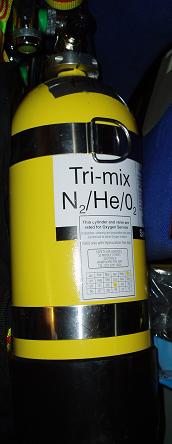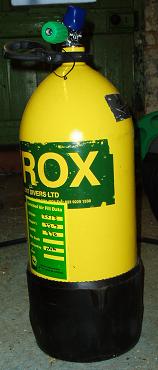300bar Cylinders
When you get a bunch of divers together who have an interest in the physics of
diving sooner or later the debate gets round to 232 vs 300bar. For some reason
this seems to bring out the bitter and twisted in people. We get the claws out
and fight. I do it, but I admit it's rather silly really.
So let me declare myself at the start. I have a 300bar twin 10L rig, a 300bar
3L pony bottle and some other 300 bar specials. I do have several 232bar
cylinders for singles diving and for the rebreather. I use 300bar for air,
nitrox and trimix and I will continue to do so.
So lets get our agreed facts together first:
Scuba cylinders have been going up in pressure over the years as the sport has
developed. However higher pressures normally imply more metal to keep the gas
inside reliably and this means more weight. Up to about 232bar this was not
really a problem as divers virtually all have to carry a weight belt to ensure
they can get down and stay down and having some of that weight actually working
for you always seems better than just carrying lead weights.
However above 232bar the gas laws that describe how much gas is in the cylinder
begin to become less simple so we are starting into a diminishing gain as more
pressure does not imply quite as much more gas as you expect but it still needs
the more metal to keep it in.
A second point is that our filling stations are becoming equipped to pump
300bar but not more. This means that if I go in with a 232bar tank and plead
the 'hurry-up's they can blow me a hot 250bar fill that will cool back to 232
(ish) by the time I'm on the boat but 300bar cylinders can't get 320 or so
because the system maxes out at 305 or so. Add to this that some places quick
fill as a matter of course and so you always end up a bit short when you plonk
the tank into cold water. It sums up that although you can routinely get 300bar
now you are more often able to get a good 232bar fill than a
good 300bar one.
Also there is the problem of weight. Nobody is going to deny that scuba tanks
are heavy. Twinsets are heavier still and we have developed tricks, like the
metal backplate and harness to moderate the problem but climbing up jetties and
getting to and from the carpark can be... well... tedious.
If we're talking about weights I suppose you want some numbers so I'll
introduce you to some of the cylinders I have at home:
The three figures are the ratings, then the actual volume of air when filled to
rated pressure and finally the weight stamped on the tank so that is without
valves, boots and even stickers.
| 3L 232bar steel |
3L 300bar steel |
7L 232bar steel |
10L 300bar steel |
12L 232bar steel |
12L 300bar carbon fibre |
| 689L |
826L |
1608L |
2754L |
2757L |
3305L |
| 4.0Kgms |
4.5Kgms |
8.8Kgms |
14.3Kgms |
16.7Kgms |
10.8Kgms |
 |
 |
 |
 |
 |
 |
So what do we learn from that?
Ignore the Carbondive one on the end. You can't get them yet even if I have
two. I'm just showing off. They float by the way...
Now the first thing I notice is that my 12L/232bar cylinders are relatively
heavy. They are the shape called dumpies and I would have expected about
13Kgs for a normal tank with a 232bar 10L being about 11Kgs. Perhaps the shape
makes a difference.
Well for the 3L cylinders the 300bar one was
12% heavier and held 20% more gas while at 10L the weight difference would be
about 30% more weight. That seems to make sense as they have 30% more pressure
to resist. Based on simple gas laws you would have expected 30% more gas to
match but that's what we were talking about on the gas laws not working in
your favour.
So what is the result of me putting my 10L/300bar twinset on my back compared
with a more conventional 12L/232bar set? Well....
It weights 28.6Kgs and contains 5508L of gas
against say 26Kgs and containing 5514L.
However it is 3.6L smaller (4L less hole in the middle but 0.4L more steel)
so it displaces 3.6L less of water so in total I have to take 6.2Kgs, say 13
pounds, of lead off my belt. Climbing the ladder on a hard boat I am 3.6 kilos
total lighter, which I appreciate, although RIB diving I hand off this wimpy
little weight belt and have to help drag this bigger rig over the side.
The downside is getting fills. On the south coast most places pump 300 bar
these days. However because they pump 300bar as I said earlier they can easily
do a good fill on a 232bar rig while 300 is right at the top. I do it myself.
Push the 232 rig up to 245 and when it cools down it will be right. The 300bar
rig will only go to 305bar on a good day as that's where the bank maxes out so
a good fill means dragging it out and dumping it in the kit rinse tub for five
minutes and frankly I'm not sure I can be bothered even for my own tanks so it
isn't really 3L of gas between them, it's more like 300.
Also there used to be a problem getting accurate nitrox mixes but that has
largely gone now. Places that pump 300bar know what to do and can easily get
within 1% of target. It's not hard and they do it.
My Conclusion?
There isn't much in it. My twinset suits me as it is shorter than 12s but that
is only an advantage to me as I use it inverted. I like the reduced weight as
I tend to dive hard boats rather than RIBs and I need everything going for me
as climbing a ladder in a bouncy sea I feel my age.
However, as they say, your milage may vary.

by Nigel Hewitt











